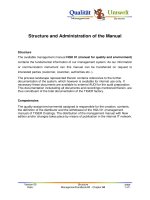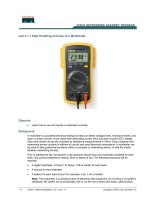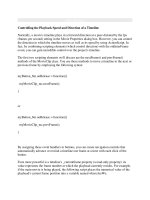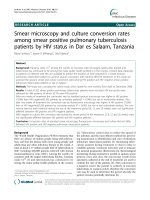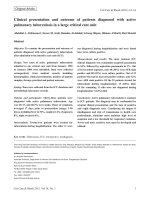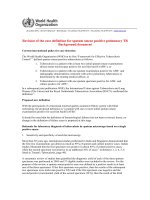Sputum smear negative pulmonary tuberculosis: sensitivity and specificity of diagnostic algorithm docx
Bạn đang xem bản rút gọn của tài liệu. Xem và tải ngay bản đầy đủ của tài liệu tại đây (269.99 KB, 6 trang )
RESEARCH ARTICLE Open Access
Sputum smear negative pulmonary tuberculosis:
sensitivity and specificity of diagnostic algorithm
Hedwiga F Swai
1*
, Ferdinand M Mugusi
2
and Jessie K Mbwambo
3
Abstract
Background: The diagnosis of pulmonary tuberculosis in patients with Human Immunodeficiency Virus (HIV) is
complicated by the increased presence of sputum smear negative tuberculosis. Diagnosis of smear negative
pulmonary tuberculosis is made by an algorithm recommended by the National Tuberculosis and Leprosy
Programme that uses symptoms, signs and laboratory results.
The objective of this study is to determine the sensitivity and specificity of the tuberculosis treatment algorithm
used for the diagnosis of sputum smear negative pulmonary tuberculosis.
Methods: A cross-section study with prospective enrollment of patients was conducted in Dar-es-Salaam Tanzania.
For patients with sputum smear negative, sputum was sent for culture. All consenting recruited patients were
counseled and tested for HIV. Patients were evaluated using the National Tuberculosis and Leprosy Programme
guidelines and those fulfilling the criteria of having active pulmonary tuberculosis were started on anti tuberculosis
therapy. Remaining patients were provided appropriate therapy. A chest X-ray, mantoux test, and Full Blood Picture
were done for each patient. The sensitivity and specificity of the recommended algorithm was calculated.
Predictors of sputum culture positive were determined using multivariate analysis.
Results: During the study, 467 subjects were enrolled. Of those, 318 (68.1%) were HIV positive, 127 (27.2%) had sputum
culture positive for Mycobacteria Tuberculosis, of whom 66 (51.9%) were correctly treated with anti-Tuberculosis drugs
and 61 (48.1%) were missed and did not get anti-Tuberculosis drugs. Of the 286 subjects with sputum culture negative,
107 (37.4%) were incorrectly treated with anti-Tuberculosis drugs. The diagnostic algorithm for smear negative
pulmonary tuberculosis had a sensitivity and specificity of 38.1% and 74.5% respectively. The presence of a dry cough, a
high respiratory rate, a low eosinophil count, a mixed type of anaemia and presence of a cavity were found to be
predictive of smear negative but culture positive pulmonary tuberculosis.
Conclusion: The current practices of establishing pulmonary tuberculosis diagnosis are not sensitive and specific
enough to establish the diagnosis of Acid Fast Bacilli smear negative pulmonary tuberculosis and over treat people
with no pulmonary tuberculosis.
Keywords: Sputum smear negative, Human Immunodeficiency Virus, Symptoms
Background
There has been a sharp rise in the incidence of pulmonary
tuberculosis (PTB) worldwide since the mid 1980’s, parti-
cularly in the Sub-Sah aran African region . This has been
attributed mainly to the appearance and wide spread of
Human Immunodeficiency Virus (HIV) infection on the
continent [1-3]. For the diagnosis of PTB the detection of
Acid Fast Bacilli (AFB) in expectorated sputum is still cru-
cial, especially in dev eloping countries of Sub-Sa haran
Africa, where other facilities including sputum culture for
Mycobacterium Tuberculosis (MTB) are unavailable or
are prohibitively expensive. When AFB is detected in spu-
tum, the diagnosis of PTB is certain. However diagnostic
problem start when patients with suspected PTB have a
negative sputum smear [4]. It has always been recognized
that a proportion of patients are sputum smear negative
using the Ziehl-Nelseen (ZN) stain, the commonly used
stain in most laboratories in the region to detect AFB in
* Correspondence:
1
Department of Internal Medicine Muhimbili National Hospital, Dar-es-
salaam, +255 Tanzania
Full list of author information is available at the end of the article
Swai et al. BMC Research Notes 2011, 4:475
/>© 2011 Swai et al; licensee BioMed Central Ltd. Thi s is an open access article dist ributed under the terms of the Creative Commons
Attribution License ( which permits unrestricted use, distribution, and reproduction in
any medium, provide d the original work is prop erly cited.
sputum. This is a simple, rapid and cheap test but lacks
sensitivity of a single sputum test [4]. About 5000 bacilli
per milliliter of sputum must be present for it to be posi-
tive. However it has been reported that multiple sputum
tests in a good laboratory can give a s ensitivity of about
90% [5]. Sputum smear using ZN stain for AFB seems to
be even less sensitive in patients with HIV associated PTB.
With the sharp rise of PTB in countries which a re worst
affected by the HIV epidemic s, the number of patients
with suspected PTB who are sputum smear negative has
increased [5].
Chest radiography is not always helpful in smear nega-
tive patients. The radiographic distinction between active
and inactive tuberculosis can be difficult and appearanc e
may be atypical due to other infections in HIV positive
patients [4]. In fact, substantial numbers of patients are
treated for tuberculosis without definitive diagnostic cri-
teria [5]. With the advent of HIV assoc iated tuberculosis
with more frequent smear negative tuberculosis, the role
of culture i n TB control programs may need to be reas-
sessed [4]. In countries where resources are limited, and
wheretheuseofchestX-raysmaybeinadequatedueto
the cost as well as atypical presentation found in HIV
infected patients, clinical and/or laboratory characteris-
tics which are able to identify smear negative but culture
positive PTB are required. The Tanzania National TB
and Leprosy Programme uses a smear negative PTB diag-
nostic algorithm adopted from the World Health Organi-
zation (WHO) (Figure 1) [6].
This study was conducted with the aim of assessing
the sensitivity of the current recommended algorithm
for the diagnosis of sputum smear negative PTB.
Methods
A cross-sectional study with prospective enrollment was
conductedatMuhimbiliNationalHospital(MNH),a
university teaching and national referral hospital, and at
out-patient tuberculosis clinics at the Infectious Disease
Clinic (IDC), Mwananyamala, Temeke and Ilala district
hospitals, from September 2000 to December 2000. All
these hospitals are locate d in the city of Dar es Salaam.
The city accounts for over 26% of all new tuberculosis
cases reported each year in Tanzania [7].
Adult male and female patients aged 18 to 75 years,
presenting with chronic cough (≥2 weeks); who were
three times sputum smear-negative for AFBs (ZN stain);
and who gave a written informed consent to participate
in the s tudy and for HIV testing were included into the
study. Patients with known tuberculosis or who had PTB
in the past, on anti-TB for treatment or prophylaxis;
those with known chronic respiratory diseases (e.g. bron-
chial asthma, chronic obstructive pulmonary disease,
bronchiectasis), those with misplaed HIV results, con-
taminated cultue results andthosewithheartfailure
were excluded. The study protocol was approved by the
MUHAS Ethical Review Committee.
Study procedures
A detailed medical history and physical exami nation was
done by a study clinician and the findings were recorded
on a clinical record fo rm. The investigators did not inter-
fere in the treatment of these patients. The treatment
cent re followed the diagnostic algorithm for smear nega-
tive. Laboratory tests included a complete blood count
(coulter counter model, manufacturer, city and country)
which included estimation of haemoglobin, red blood cell
count and indices; and white blood cell count both total
and differential. A peripheral blood smear for assessment
of red cell morphology was also made. Erythrocyte sedi-
mentation rat e (ESR) was set using the Westergren
method within 2 hrs of drawing blood.
HIV testing was done according to the Tanzania
National AIDS guidelines. Each patient received pre- and
post-test counseling and the HIV test was done using a
dual ELISA algorithm. Sera which were non-reactive on
first ELISA were considered HIV antibody negative, and
those reactive on first ELISA were retested by a second
ELISA based on a different test principle. Sera reactive
on both ELISA tests were considered HIV-positive. Sam-
ples with discordant test results were confirmed by Wes-
tern blot (WB) and western blot interpretation was done
according to the WHO criteria [8].
Patients who came to the clinic with symptoms sugges-
tive of PTB had their sputum examined. Those who were
three times smear n egative were consequently selected
and asked to bring one more sputum sample which was
sent to the Tuberculosis Reference Laboratory at MNH
for AFB culture (Löwenstein-Jensen culture media).
Smears were considered positive if AFBs were seen on
smear from any of the three sputum samples. Patients
found to have sputum smear positive were treated for
tuberculosis according to the National Tuberculosis and
Leprosy program treatment guidelines. Those found to
have sputum smear negative for AFB and who consented
were enrolled into the study. A chest x-ray was ordered
for those who were found to be HIV positive. If the chest
x-ray results were abnormal, the patient was considered to
have sputum smear negative PTB, and started on anti-TB
medications. The rest were treated with broad-spectrum
antibiotics. All enrolled patients were requested to stay at
the clinic for a month for follow up. Two weeks later,
patients on broad spectrum antibiotics were evaluated
again by doing sputum smear and chest radiograph. Those
found to have smear negative sputum but had symptoms
still suggestive of PTB were treated as smear negative
PTB; others were treated accordingly.
Two weeks later we came back to review treatment of
clinician of which others were given ant TB and others
Swai et al. BMC Research Notes 2011, 4:475
/>Page 2 of 6
were treated for other respiratory problems. Because
they followed NTLP diagnostic algorithm, all of them
had a chest X-ray done, and all of them were reviewed
and reported using a structured format by two indepen-
dent radiologists. In case of disagreement in their initial
independent reporting, they reviewed the radiographs
together and resolved the disagreement by consensus.
Sample size and data analyisis
Power calculations
This study was part of another study on that aimed to
investigate/examine sputum smear negative but culture
positive PTB the association with HIV.
Assuming a sensitivity of 50% and specificity of 75%, a
sample of size 413 subjects would give a 95% confidence
interval of plus/minus 0.048% for sensitivity and plus/
minus 0.042% for specificity. This is a reasonable
amount of precision for the given sample size.
Data were analyzed using Statistical Package for Social
Sciences (SPSS) and EPI Info. Pearson chi -square test
was used for comparison of categorical data and a stu-
dent t-test was used for continuous data. Logistic
regression ana lysis was applied and the direct effects of
the predictors were assessed by their 95% confidence
intervals. A p-value of < 0.05 was considered to be sta-
tistically significant.
Sensitivty and specificity of the diagnostic algorithm
was calculated using the following formulas:
Sensitivity =
Diseased
Positive test
Specificity =
Health individual
Test negative
Positive and negative predictive value was calculated
using the following formlas
Positive predictive value =
TP
TP + FN
=
True positive
Total positive
Negative predictive value =
TN
TN + FP
=
True negative
Total negative
Results
Over the course of the study, 467 patients were enrolled.
Of those enrolled, 318 (68.1%) were HIV positive.
Visit 1
Visit 2
Visit 3
Visit 4
Visit 5
TB suspect
2 AFB sputum samples for smear microscopy
(Spot and monitoring) and offer PITC if HIV status unknown
1 and 2 AFB sputum
Treat for TB and
give CPT
if HIV +
If HIV Positive
Clinical assessment
Request CXR
Give CPT
2 AFB sputum
smear negative
If HIV negative or PITC refused
clinical assessment
provide broad spectrum
antibiotic
assess after 7 days
TB likely: treat
for TB and give
CPT
CXR suggestive
and
clinical judgment
suggestive for TB
CXR not
suggestive
Provide broad
spectrum antibiotics
assessment after 7
days
No improvement
If improved TB unlikely
Reassess clinically, repeat sputum for TB and
request CXR
If improved:
TB likely
No improvement
Reassess clinically and repeat sputum for AFB
If TB unlikely:
reassess for
other
conditions
If TB likely:
treat for TB
If TB unlikely: reassess for other
conditions
If TB likely:
treat for TB
Figure 1 Flowchart on the diagnosis of pulmonary TB in children above 6 years and adults.
Swai et al. BMC Research Notes 2011, 4:475
/>Page 3 of 6
Sputum was culture positive for MTB in 27.2% (127/
467) of patients; sampl es of 11.1% (52/467) patients
were reported to have been contaminated. In the
remaining 61.7% (288/467) patients sputum was culture
negative for MTB at 8 weeks. Of the 467 study subjects,
68.1% (318/467) were HIV positive. Two study subjects
whose culture results were negative had their HIV
results m isplaced. These two, together with the 52 sub-
jects whose culture results were contaminated were
excluded from further analysis. Of the 413 samples ana-
lyzed, 30.8% (127/413) were MTB culture positive.
There was a high proportion of PTB patients who were
not treated as well as a high proportion of patients with-
out TB who were treated with anti TB [Table 1]. As
observed the diagnostic procedure at the clinics had a
sensitivity of 38.1% and a specificity of 74.5%. The posi-
tive predictive and the negative predictive diagnostic
value were 52% and 62.5% respectively [Table 2].
Of those who were presumptively diagnosed to have TB,
the diagnosis of TB was established in HIV negative
(58.1%) more than positive subjects (48.8%) [Table 3].
Using an unadjusted logistic regression model character-
istics which predicts smear negative culture positive were
determined. Matted lymph node, tachypnoea (RR > 2 0),
presence of a cavity, mixed type of anaemia, were strong
predictors of PTB culture positivity. Eosinophilia was also
found to be associated with a 50% less chance of being
sputum culture positive [Table 4].
In an attempt to develop supplemental method for diag-
nosing smear negative pulmonary tuberculosis, forward
stepwise multiple logistic regression analysis of the data
was done to establish clinical and laboratory characteris-
tics that predict the presence of sputum culture positive.
Using this analysis, high respiratory rates, lo w eosinophil
counts, mixed type of anaemia and the presence of cavities
on X-rays were predictors of smear negative but culture
positive[Table 5].
Discussion
This study showed that of those found to have a nega-
tive result for AFB, a significant proportion (27.2%) had
sputum culture positive for MTB. Therefore our data
indicate that smears did not detect PTB in a very large
proportion of patients. Sputum culture being the gold
standard for the diagnosis of Tuberculosis disease [9]
showsthatsputumsmearisnotaverysensitivetoolin
the diagnosis of PTB. This has been shown by other stu-
dies where sensi tivity has been described to be between
51% to 53.3% [10,11]. One of the reasons for low sensi-
tivity is reported to be due to the fact that 10
4
/ml are
required for AFB to be seen using smear microscopy [4].
Although the gold standard for the d iagnosis of Tubercu-
losis involves the isolation and identification of Mycobac-
terium Tuberculo sis (MTB) using cultures [9], the cost and
facilities of doing cultures are prohibitive in most develop-
ing countries. S putum smear mic roscopy remains the main
diagnostic tool for PTB that allows initiation of treatment
and monitoring of patient progress [11,12]. As sputum
smear and microscopy is not a very sensitive tool in the
diagnosis of PTB, presumptive diagnosis is usually made
based on an algorithm of clinical and radiological criteria.
This is commonly termed as AFB negative PTB [9,13]. In
some cases when sputum smears are negative but the
patient has clinical features highly suggestive of PTB,
broad-spectrum antibiotics are recommended for at lest
10-14 days and sputum smears repeated. If the patient’s
condition does not improve while sputum smear remains
negative, a chest radiograph is done and if found to be
abnormal, a presumptive diagnosis of PTB is made and the
patient is started on anti-Tuberculosis treatment as AFB
negative PTB [9]. In this study patients whose sputum
smears were AFB negative, were evaluated using the above
algorithm by the treating doctors at the clinics or hospital.
A presumptive diagnosis of AFB sputum s mear negative
PTB was made in 41.8% (173) of all study subjects, and
patients were started on anti-TB treatment as recom-
mended by th e Tanzania NTLP. The remaining 58.2%
(240) patients were assumed to h ave other forms of
respiratory diseases and were treated accordingly.
Table 1 Diagnosis made using culture results and
Treatment given
Treatment given Culture +ve
(n = 127)
Culture -ve
(n = 286)
Total
(n = 413)
Ant-TB 66(51.9) 107(37.4) 173(41.8)
Antibiotics without anti-TB 61(48.1) 179(62.6) 240(58.2)
Table 2 Sensitivity and specificity of the diagnostic
procedure of patients with smear negative
TB treatment Disease status Total
Culture +ve Culture -ve
Yes 66 107 173
No 61 179 240
Total 127 286 413
Positive predictive value = 52%
Negative predictive value = 62.6%
Sensitivity = 38.1%
Specificity = 74.5%
Table 3 Diagnosis made and Treatment given by
subjects’ sputum culture results and HIV sero-status
Treatment given Culture +ve Culture -ve
HIV +ve HIV -ve HIV +ve HIV-ve
n = 84 n = 43 n = 203 n = 83
Anti-TB 41(48.8) 25(58.1) 70(34.5) 37(46.3)
Antibiotics 43(51.2) 18(39.5) 133(65.5) 46(53.7)
Swai et al. BMC Research Notes 2011, 4:475
/>Page 4 of 6
Less than half (38.1%) of those who were presumed to
have active TB and started on Anti TB actually had TB by
sputum culture results. More than 60% of these patients
they received 8-months of treatment despite having a
neg ative culture results. This is si milar to what has been
reported before in Malawi were it was reproted that 40%
of smear negative had TB confirmed microbio logically
after taking Broncho alveolar larvage [14]. The treatment
of individuals without tuberculosis adds to the cost of the
TB programs in most developing countries. Likewise
about 48% (61) of patients who had active tuberculosis by
the r esults of sputum culture were missed and they
received inappropriate treatment, leaving them vulnerable
to developing severe disease as well as remaining source of
TB infection in the community.
The current diagnostic algorithm leading to the estab-
lishment of the diagnosis of AFB smear negative PTB is
inefficient; it over-diagnoses PTB and misses a lot of peo-
ple with active disease. Instituting a more sensitive
diagnostic tool will prevent the unnecessary cost of treat-
ing individuals who do not have TB and at the same time
it will prevent the further spread of TB. This emphasizes
the need of culture and the need of further research in
order to identify a better diagnostic tool for diagnosis of
AFB negative PTB.
In an attempt to improve on the diagnosti c algorithm,
the study looked at the clinical presentation of the patients
to identify clinical laboratory and radiological features that
are asso ciated with smer negative PTB and which can be
used to predict PTB in patients with symptoms suggestive
of PTB. A multivariate analysis showed the following fea-
tures to be highly predictive of AFB negative but culture
positive PTB; low eosinophil counts, a mixed type of anae-
mia and the presence of cavities on chest radiographs.
Low eosinphil seems to be an incidental finding Further
studies have to be done to confirm this findings
Limitation in the current study is the inclusion of
patients with cough of more than two weeks in which
there may be inclusion of patients with simple chest infec-
tion that sometime may be complicated with cough for 2-
3 weeks. This may be a selection bias that may explain the
low sensitivity and specificity of the diagnostic algorithm.
Another limitation is the method of sputum delivery,
which is delivered by the patient himself, may have
affected the results as some might bring saliva.
We could not be certain that the algorithm was followed
at all times because resechers were not involved in the
management of these patients rather we evaluated the
treatment gien to patients by the attending clinicians. In
Tanzania National TB and Leprosy programme is well
organized and the algorithm is well adhered by the District
TB and Leprosy Coordinators and all workers of the
NTLP who were the attending clinicians in this study.
Table 4 Unadjusted bivariate logistic regression analysis of clinical characteristics predictive of smear negative culture
positive PTB
Characteristics OR Confidence interval P-value
Resp rate > 20/min 2.5 1.3-4.8 0.005
< 20/min 1
Lymphnode None 1
Matted 2.8 1.1-7 0.03
Discrete 1.2 0.5-2.7 0.6
Eosinophilia < 0.4 1
> 0.4 0.5 0.2-0.8 0.01
Cavity Abscent 1
Present 74 9.2-598 0.0001
Cavity right mid 11 0.8-139.7 0.06
Cavity other sites NS
RBC morphology Normocytic 1
Microcytic 0.8 0.4-1.7 0.6
Macrocytic 0.01 0.000-407516 0.7
Mixed 2 1.1-3.5 0.003
Table 5 Multivariate analysis of clinical characteristics
predictive of smear negative culture positive PTB
Characteristics OR Confidence interval P-value
Respiratory rate > 20/min 2.4 1.2-4.4 0.0054
< 20/min 1
Eosinophilia < 0.4 1
> 0.4 0.5 0.2-0.8 0.0094
Cavity Abscent 1
Present 74.3 9.4-587 0.0000
RBC morphology Normocytic 1
Microcytic 0.8 0.4-1.7 0.6
Macrocytic 0.01 0.000-39171193 0.69
Mixed 2 1.2-3.7 0.01
Swai et al. BMC Research Notes 2011, 4:475
/>Page 5 of 6
Conclusion
• The current procedures of establishing AFB negative
PTB are not s ensitive enough to establish the diagnosis
of active tuberculosis. They under-diagnose PTB and
over treat people without PTB.
• The presence of a dry cough, a high respiratory rate,
a low eosinophil count, a mixed type of anaemia and
presence of a cavity were found to be predictive of
smear negative but culture positive PTB.
Consent
The study protocol was approved by the MNH Ethical
Review Committee.
Written consent was obtained. To those who were not
able to write oral consent was obtained
The strength of our study is that it evaluates very well
the dignostic algorithm.
Recommendations
1. We do not recommend adhering to the diagnostic
algorithm.
2. A much more sensitive diagnostic algorithm for
smear negative pulmonary tuberculosis should be devel-
oped to be able to identify those individuals who are
actually sputum culture positive for AFB.
List of Abbreviations
HIV: Human Immunodeficiency Virus; PTB: Pulmonary Tuberculosis; AFB: Acid
Fast bacilli; MTB: Mycobacterium Tuberculosis Mycobacterium Tuberculosis;
NTLP: National Tuberculosis and Leprosy Proagramme; ZN: Ziehl-Nelseen;
IDC: Infectious Disease Clinic; TB: Tuberculosis; Anti-TB: Anti-tuberculosis
drugs; RR: Respiratory rate; MNH: Muhimbili National Hospital; WHO: World
Health Organization; ELIZA: Enzyme Immunosorbent assay; SPSS: Statistical
Package for Social Sciences; OR: Odds ratio.
Acknowledgements
The study was supported by the Muhimbili University of Health and allied
Sciences. We wish to thank Dr Kazema and Dr Kimaro (X-ray and imaging
specialists) who read all the X-rays. We thank and Mr Ngowi and Mr
Shogolo (Laboratory technicians) for storing and working on the sputum
samples. I thank doctors who assisted in data collection and last but not list
I wish to thank Dr Makwaya (Biostatician) for assisting in sample size
calculation and data analysis.
Author details
1
Department of Internal Medicine Muhimbili National Hospital, Dar-es-
salaam, +255 Tanzania.
2
Department of Internal Medicine Muhimbili
University of Health and Allied Sciences. Dar-es-salaam, +255 Tanzania.
3
Department of Psychiatry Muhimbili National Hospital. Dar-es-salaam, +255
Tanzania.
Authors’ contributions
FM participated in the design of the study, proof read the manuscript and
performed statistical analysis. HS participated in the design of the study,
collect data, drafted the manuscript, and performed statistical analysis. JM
participated in the statistical analysis and proof read of the manuscript. All
authors’ read and approved the manuscript.
Competing interests
The authors declare that they have no competing interests.
Received: 14 March 2011 Accepted: 1 November 2011
Published: 1 November 2011
References
1. Colebunders RL, Ryder RW, Nzilambi N, Dikilu K, Willame JC, Kabito M, et al:
HIV infection in patients with tuberculosis in Kinshasa, Zaire. Am Rev
Respir Dis 1989, 139:1082-1085.
2. Elliot AM, Luo N: Impact of HIV infection in Zambia A cross sectional
study. BMJ 1990, 301:412-415.
3. Timpe A, Runyon EH: The relationship of “atypical” acid-fast bacteria to
human disease: A preliminary report. J Lab Clin Med 1954, 44:202.
4. Barker A: Sputum amear negative PTB. Tropical Doctor 1993, 23:145-146.
5. World Health Organization Geneva. TB Control as an Integral part of
primary health care 1988, 11.
6. Manual of the National Tuberculosis and Leprosy Programme in
Tanzania fifth edition. 2006.
7. Donald A, Murray FEarson John: Global epidemiology of Tuberculosis. In
Tuberculosis first edition. Edited by: William N Rom, Stuart M Garay. Brown
and company; 1996:.
8. Millar JG: On the spread and prevention of tuberculosis disease in Pond
land, South Africa. BMJ 1908, 1:380-383.
9. Treatment of Tuberculosis guidelines for National Programmes. World
Health Organization; 1997.
10. Vignesh Ramachandran, Balakrishnan Pachamuthu, Shankar Muthu Esaki,
Murugavel Gangatharan Kailapuri, Hanas Settu, Cecelia Jebaraj Anitha,
Solomon Suniti, Kumarasamy Nagalingeswaran: Value of single acid-fast
bacilli sputum smears in the diagnosis of tuberculosis in HIV-positive
subjects. J Med Microbiol 56(2007):1709-1710.
11. Cattamanchi Adithya, Dowdy WDavid, Davis J Lucian, Worodria William,
Yoo Samuel, Joloba Moses, Matovu John, Philip CHopewell,
Huang Laurence: Sensitivity of direct versus concentrated sputum smear
microscopy in HIV-infected patients suspected of having pulmonary
tuberculosis. BMC Infectious Diseases 2009, 9:53, 1471-2334-9-53.
12. Harries AD, Maher D: TB/HIV A clinical manual. World Health Organization;
1996, 20.
13. Manual of the National Tuberculosis and leprosy programme in
Tanzania. , Fifth 2006, 22.
14. Hargreaves NJ, Harries AD, kemp JR, kwanjana JH, Salaniponi FM: Smear
-negative pulmonary tuberculosis: defining better approaches to case
finding and care in Malawi. Review article in Malawi medical journal .
doi:10.1186/1756-0500-4-475
Cite this article as: Swai et al.: Sputum smear negative pulmonary
tuberculosis: sensitivity and specificity of diagnostic algorithm. BMC
Research Notes 2011 4:475.
Submit your next manuscript to BioMed Central
and take full advantage of:
• Convenient online submission
• Thorough peer review
• No space constraints or color figure charges
• Immediate publication on acceptance
• Inclusion in PubMed, CAS, Scopus and Google Scholar
• Research which is freely available for redistribution
Submit your manuscript at
www.biomedcentral.com/submit
Swai et al. BMC Research Notes 2011, 4:475
/>Page 6 of 6
